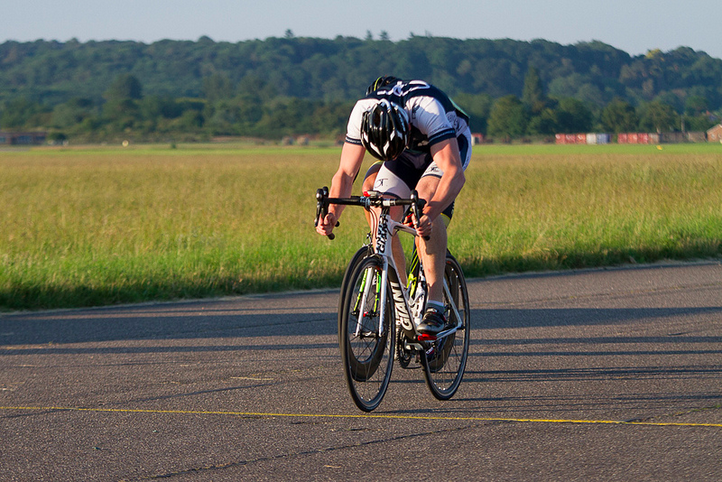The agony and ecstasy of cycling in Richard Poplak’s “The Pain Principle”
This 2013 Walrus feature is not only a meditation on cycling, but also a snapshot of a cyclist’s life on the brink of breakthrough—just before a doping scandal.
[[{“fid”:”4484″,”view_mode”:”default”,”fields”:{“format”:”default”,”field_file_image_alt_text[und][0][value]”:””,”field_file_image_title_text[und][0][value]”:””},”type”:”media”,”link_text”:null,”attributes”:{“height”:”482″,”width”:”722″,”style”:”width: 400px; height: 267px; margin-left: 10px; margin-right: 10px; float: right;”,”class”:”media-element file-default”}}]]By Marissa Dederer
Richard Poplak, “The Pain Principle,” The Walrus, July 2011
Richard Poplak’s profile of cyclist Ryder Hesjedal’s ability embrace the pain of road cycling appeared on newsstands in 2013—before major doping revelations of that year claimed supposedly unimpeachable riders such as Lance Armstrong, and even Hesjedal himself.
Poplak’s story examines, in part, what might lead a cyclist to cheat, to make his body more capable of enduring the agony of road cycling. “A cyclist dopes, and it allows him to race faster, which means harder, which means a few extra slices of agony on his already unpalatable pain sandwich. He suffers more, and he suffers better. Doping is a porthole into greater pain, which is both the sport’s essence and its undoing,” writes Poplak. And it is Hesjedal who seems above it all, impervious to the temptation (he admitted in 2013 that he had doped in the early 2000s, but that it was behind him).
Poplak takes us deep into the world of cycling through Hesjedal. We are introduced to the rider in Spain, during the Vuelta al País Vasco (Tour of the Basque Country), and he is just on the brink of his breakthrough. It is a profile of a man who is about to reach the peak of fame.
The story weaves in and out of the six-day race series in Spain and we learn more about Hesjedal’s life growing up in British Columbia, his mountain biking days, the series of teams he raced for and, inevitably, of his desire to stay clean in a dirty sport.
Poplak lures us in with his use of simile and metaphor. “A cycling team’s hotel floor looks like a geriatric ward: men lie prostrate on beds, pink feet pointing skyward,” he writes. The directeur sportif Bingen Fernández “is like an orchestra conductor. He has the sheet music in front of him, in the form of that topographic profile of pain.”
His imagery is also precise. When he first meets Hesjedal in Spain, he describes the cyclist as “an early version of Mr. Fantastic,” and almost as an afterthought, describes his bent torso: “cyclists, like velociraptors, are unburdened by upper body strength.” Later, he describes Fernández as “long of nose, high of forehead . . . [and] looks as if he was designed in a wind tunnel.”
But where the piece really shines is in its relay of what it could possibly be like to suffer the way elite cyclist suffers. Poplak drives home this point repeatedly: “No other sport demands the same time, pain, and work ethic. You cannot race a Grand Tour without being in supreme physical shape, so fit that you are actually eating yourself, and must consume the same amount of food and liquid as nearly three grown men—which amounts to about 6,000 calories a day—to stay alive.”
Poplak, along for the ride of the bike race, paints the vistas that the riders see as they push their bodies to the limit. His scenes are vivid but he never actually rides the bike, instead getting inside the head of the rider and in peloton. We come to understand what a living, breathing mechanical machine the group is, as well as its inner workings.
Littered throughout the piece is an alphabet soup of French cycling words, from soigneurs to domestique. We are reminded that cycling is indeed a European sport, and the arc-de-triomphe is the Tour de France.
“The Pain Principle” is not only a meditation on cycling, but also a snapshot of Hesjedal’s life: on the brink of a breakthrough, yet before the dreaded doping spotlight is shone on his now-distant past. And though Poplak writes that “writing about cycling’s meta-state is like dancing about architecture,” and that “it is a private knowledge, forged in pain’s stables, and belongs to men who are not served by articulating it,” in attempting to, he does succeed.
[[{“fid”:”4485″,”view_mode”:”default”,”fields”:{“format”:”default”,”field_file_image_alt_text[und][0][value]”:””,”field_file_image_title_text[und][0][value]”:””},”type”:”media”,”link_text”:null,”attributes”:{“height”:”380″,”width”:”380″,”style”:”width: 100px; height: 100px; margin-left: 10px; margin-right: 10px; float: left;”,”class”:”media-element file-default”}}]]Marissa Dederer is a writer and photographer based out of Calgary, Alberta. She is a graduate of Ryerson’s School of Journalism, and currently at the Whitecourt Star.
Illustration photo by Jun, via Flickr.

